Bellingham WA
Pacific Northwest
July — Sept. 2019
In early July, a pair of Glaucous-Winged Gulls (Larus glaucescens, GWG) appeared on my neighbor’s roof having built a rather skimpy nest tucked up against the chimney and roof top. GWGs tend to nest in colonies on rocky ledges, on the ground or on rooftops against chimneys, as did these. They appeared diligent and attentive to the nest which I assumed contained the 2 or 3 eggs typical of these gulls. I could not see in the nest as it was behind the chimney from me and I was limited to seeing only some twigs and the occasional tail feathers protruding beyond the chimney when they sat on the eggs. (Both parents assist in incubation as well as in feeding after the hatch.)
|
The Daily Bucket is a nature refuge. We amicably discuss animals, weather, climate, soil, plants, waters and note life’s patterns spinning around us.
We invite you to note what you are seeing around you in your own part of the world, and to share your observations in the comments below.
|
After observing the parents for a few days they seemed to disappear. I wasn’t sure if I had just missed seeing them or if they had abandoned the nest. Since I could not see the nest directly to see if there were still eggs I was not sure what was up. But eventually they showed up or I happened to be looking when they were there. The range of time from laying to hatch is 26 to 29 days. They must have been laid well before I began observing. Since GWG chicks are semi-precocial and can leave the nest after one or two days, I figured that the chicks hatched on or about July 27th as my first sighting of them was on 7/29 when I spotted two grey-brown downy fuzz balls with little legs wobbling around the roof. As it turned out, there had been three eggs as my neighbor informed me that he found one egg broken on his porch, it having apparently rolled off the roof. (I still wonder just how this might have happened.)
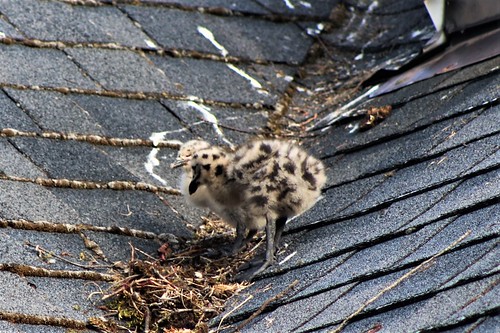 Young GWGs, a few days old on the roof checking out the debris for food. An early lesson. The chick in front was observably larger than the other one and this difference persisted until they fledged.
Young GWGs, a few days old on the roof checking out the debris for food. An early lesson. The chick in front was observably larger than the other one and this difference persisted until they fledged.
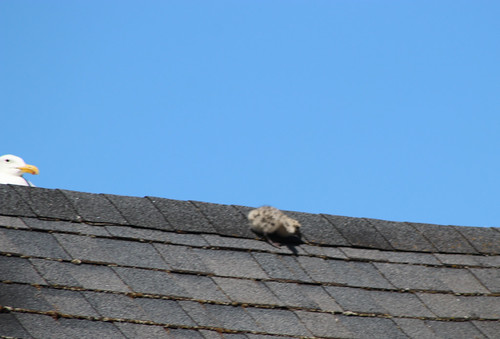 This roof is steep!
This roof is steep!
For the next six weeks these chicks were instructed by their parents on my neighbor’s roof in how to be proper GWGs. And I was instructed in how this process transpired and played out in close up “nature.” Being up close, I observed some things that I had read about, studied and seen in films but never seen first hand.
At first all they did was explore the rooftop mostly under the watchful eye of a parent.
 GWG ranges from Aleutians to Baja
GWG ranges from Aleutians to Baja
The Glaucous-winged Gull (GWG) is our most prevalent gull and often hybridizes with its close cousins, the Western Gull among others. These parents appear to be pure GWGs as their wingtips show no color variation from their back colors of “glaucous” (blue-grey). In all, their population, including the hybrids, seems to be either holding steady or increasing which can be a problem for other species as the GWs rob nests and even chicks of other gulls and birds.
Until about mid August, it was not obvious that these chicks even had wings. They remained puffballs although they were getting larger. Then I noticed that actual wing feathers began replacing the fuzz and they were practicing flapping.
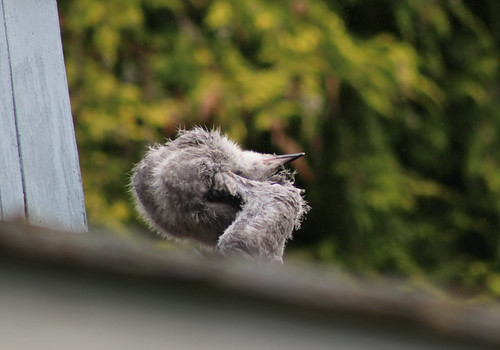 This backbend illustrates some of rituals they went through during the day in addition to picking at their down and proto feathers. The wings were finally becoming more prominent.
This backbend illustrates some of rituals they went through during the day in addition to picking at their down and proto feathers. The wings were finally becoming more prominent.
Although I was not able to see much direct feeding, it very clearly occurred on some regular schedule as the chicks seemed to grow rapidly.
 A parent GWG coming in for a food delivery for a hungry chick probably directly from the beach with a shellfish stew.
A parent GWG coming in for a food delivery for a hungry chick probably directly from the beach with a shellfish stew.
One “biologically programmed” feeding-related behavior that I knew of but had not seen up close or photographed before was the operation of the “sign stimulus” response taken from Niko Tinbergen’s ethology studies back in the 1950s. In this case some of the larger adult gulls with yellow beaks have a distinctive red spot on the lower mandible. When the chick pecks the bill (red spot is the stimulus) the parent regurgitates food for the chick. The chick’s survival is: See the red spot, peck it, get food. What a great system - Its like a natural vending machine. It seems pretty adaptive to me.
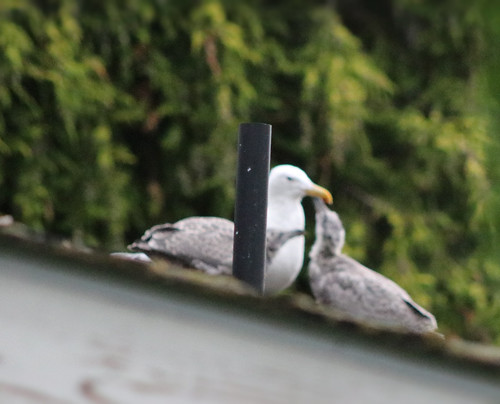 Sign stimulus in action.
Sign stimulus in action.
The next phase I observed was that as the wings developed, they became more a part of the bird’s daily activity. That is, they seemed to practice waving and flapping them as if getting used to these new feathered appendages. At this point flapping did not lift the chick, but that was to come.
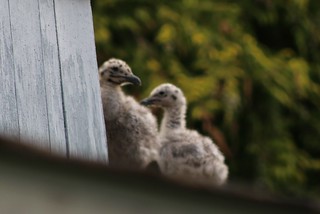 Small sibling in front
Small sibling in front
I found it interesting that these two chicks appeared to be very close. As I noted, one was clearly less developed physically than the other, yet they spent a great deal of time in quite close proximity to one another. It was common for the larger one to start to go somewhere and the smaller one would follow, albeit slower and more hesitantly like following a big sis/bro.
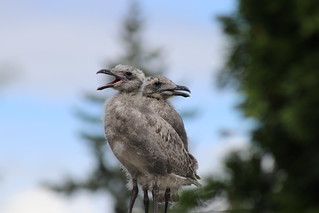 Although it looks like they are vocalizing together, often they just worked their beaks without any audible sound.
Although it looks like they are vocalizing together, often they just worked their beaks without any audible sound.
By the latter part of August, they began using their wings to good effect. At first they would use them while hopping along to help propel them up the steep roof. Similarly, I watched the smaller one slip on the roof and use its wings to correct itself and regain balance.
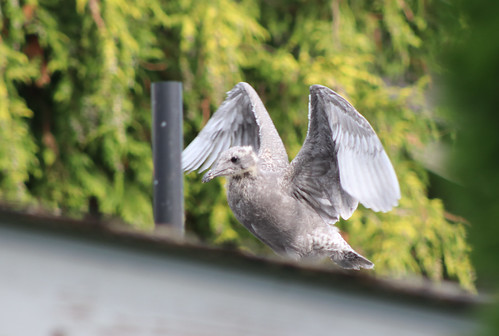 Using the wings for increased mobility and stability
Using the wings for increased mobility and stability
On September 1st, I saw the larger one actually fly for the first time. It remained on the roof but clearly lifted and flapped itself across the roof about 10 feet. Soon both were doing it. I then knew the fledge was coming.
A few days later, (9/6) not yet fledged but very active, they were just hanging out on the roof. All of a sudden I heard one of the parents making a fuss. I then saw it squawking and chasing after a raven, apparently to drive it off. In a few seconds the tables had turned and the parent gull was streaking back with the raven chasing right on its tail. They disappeared out of my sight. Soon the parent was back but still in protective mode. Another immature gull came flying over the house and again the parent took off after it warning it away. Later on that afternoon I again heard defensive squawking from a parent. This time its warnings were directed toward a small flock of pigeons that typically fly in circles around the neighborhood. The parent’s aggressive defensiveness seemed odd to me at this time since the birds were approaching full size and none of the “intruders” were all that big and not did not appear to actually be threatening the chicks. (I am wide open to hearing thoughts on this seemingly belated defensiveness.)
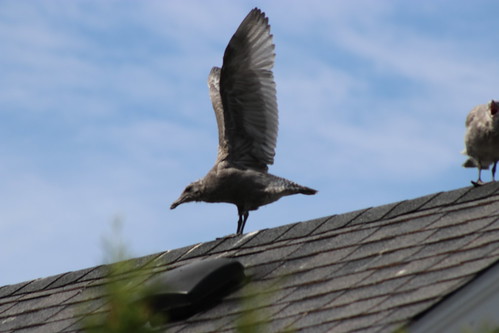 Full stretch of the wings, getting ready for the first flight.
Full stretch of the wings, getting ready for the first flight.
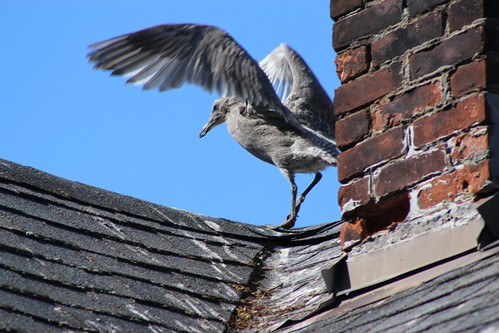 Now they are preparing for launch, but did not leave the roof at this point.
Now they are preparing for launch, but did not leave the roof at this point.
Alas the time came to fledge, but they did so carefully probably under some duress. According to The Audubon website, These Gulls fledge between 37 and 53 days from hatching and then leave the colony/nest for good two weeks after that. I estimate that these left the nest at 45 days, right in the middle of the range. But they had a bit of an assist. On Saturday night of September 7th we had a huge thunder and lightning storm with torrential downpour. I believe their nest was washed away, at least partly. On the 8th they just hung around on the front roof that orients down hill and toward the bay. I didn’t see the parents at all.
However, sometime between late Sunday and early Monday (9/9), they left their natal roof. However, they did not get far. They ended just across the street on a new roof of a house just being built as shown below.
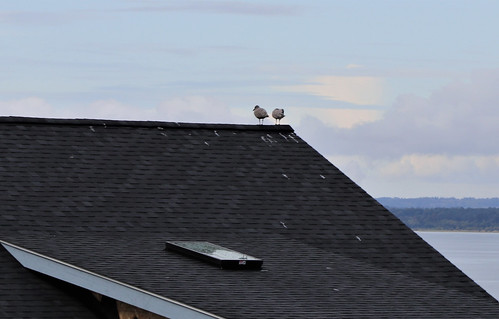 Finally they moved on to a new roof-home across the street that they immediately left their calling cards.
Finally they moved on to a new roof-home across the street that they immediately left their calling cards.
From here they seemed to have moved on for good. The following day I walked down below to see what was happening and one of the parents was on the roof of the next house down the hill seemingly calling to the semi-fledged birds and encouraging them move on.
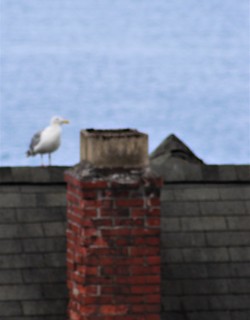 A parent calling the fledges from below to come down to the next level
A parent calling the fledges from below to come down to the next level
Apparently that was what they did as that was the last that I saw of them. They seemed to have learned a sufficient amount of gull lore to have made it to this stage of development, even if they were rousted out of their nest a bit prematurely.
ADDENDUM:
Well, that was not the last I saw of them. On 9/15, five days later, I happened to glance out to the roof across the street and Wow, I saw one of our fledges back on roof. While I can not vouch that it was one of ”my” fledglings, I’m pretty sure it was. The bird’s position on the roof was the same as the birds occupied before as you can see by the poop marks from before. The antics of stretching and bopping were there too as I had observed from them for days, I am pretty sure that one of them at least was back for a visit.
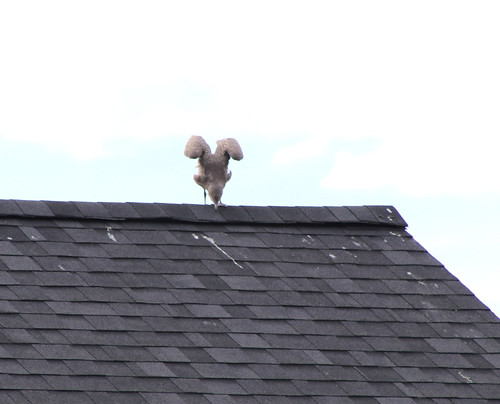 Recent fledge returns to a familiar rooftop to stretch its wings where it had previously left its mark
Recent fledge returns to a familiar rooftop to stretch its wings where it had previously left its mark
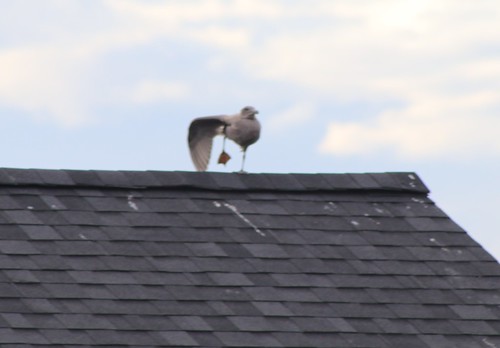 And yet another maneuver from the rooftop
And yet another maneuver from the rooftop
|
SPOTLIGHT ON GREEN NEWS & VIEWS
EVERY SATURDAY AT 3 P.M. PACIFIC TIME
DON’T FORGET TO VIEW METEOR BLADE’S COLLECTION OF LINKS AND EXCERPTS FROM ENVIRONMENTALLY ORIENTED POSTS PUBLISHED ON DAILY KOS DURING THE PREVIOUS WEEK
|
This summer it seems as if my backyard has become a local bird birthing and development center first with the Flicker family and now this one. It was however, a very “ornithologically instructive” summer for me.
So, share with us any bird propagation observations have you had over the summer.


